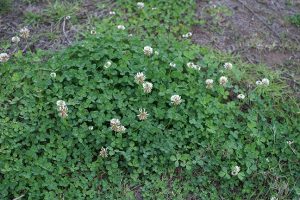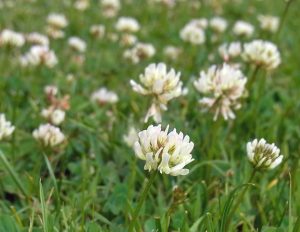Bulletin #2260, Maine Forage Facts: White Clover
Bulletin #2260, Maine Forage Facts: White Clover (PDF)
By Jaime Garzon, Assistant Extension Professor and Forage Educator, University of Maine Cooperative Extension
For information about UMaine Extension programs and resources, visit extension.umaine.edu.
Find more of our publications and books at extension.umaine.edu/publications/.
White Clover
White clover (Trifolium repens L.), also known as ladino or dutch clover, is taller, leafier, and higher yielding than the wild white clover seen in lawns. This is a low-growing plant with creeping stems (stolons) that produce roots and shoots along the stem, which helps the plant to spread. It has trifoliate leaves, with oval-shaped leaflets. There is usually a characteristic white, crescent-shaped band on each leaflet. Flowers are small white clusters at the top of stems that appear in early summer. The flower heads consist of 40 to 80 florets (individual flowers measuring 0.5 to 1.5 inches in diameter.) It reproduces by seed and creeping stolons.
The white clovers are shallow-rooted and do not have a distinct taproot like alfalfa. This root system allows these plants to survive in poorly drained soils, but persistence may be difficult in drought or winters with little snow cover.
Site selection
White clover grows best during cool, moist weather on well-drained, fertile soils with a 6–7 pH. It will stand at lower soil pH (5.5 to 6.5), but productivity will decrease due to reduced nitrogen fixation. White clover adapts fine in moist conditions but is sensitive to drought.
Soil preparation and establishment
White clover can be “frost seeded” into existing grass pastures in early spring. This technique requires seeding to be done while the soil contains frost. Delaying seeding until mid-morning, when the soil surface has become slippery, will result in poor stand establishment. For more information, check the following video:
White clover can also be no-till seeded into existing grass pastures from April to early May in Maine. Another option is to seed white clover-grass mixtures into a conventional seedbed. Do not plant deeper than ¼ inch when seeding. Press wheels or cultipacking with or after band seeding to improve the seed-soil contact and increase the germination percentage.
When seeding white clover into an existing grass pasture the seeding rate should be 2–4 pounds per acre. White clover seeds are relatively small; one pound may contain about 800,000 seeds. For frost-seeding, 4 pounds per acre is recommended. To improve germination, it is highly advised to use seed inoculated with Rhizobium trifolii bacteria.
White clover may occur naturally in many pastures, so seeding may be unnecessary in those cases.
Liming and fertilization
It is recommended that a soil test be done to determine the amount of lime and fertilizer needed for growing white clover. For best results, the soil pH should be between 6 and 7. Nitrogen fertilization should be avoided to not impact biological N fixation. In the absence of a soil test and assuming medium-fertility soil, apply 60 and 145 pounds of phosphate (P2O5) and potash (K2O) per acre after seeding. Lime should be applied at least two weeks before planting. If the white clover proportion exceeds 30% of the pasture, apply 30 to 50 pounds of nitrogen per acre to enhance grass production.
Varieties
Alice: Traditionally, there are two types of white clover: the small-leafed and highly persistent varieties and the large-leafed and less persistent varieties. Alice white clover was the first variety that successfully combines production (large leaves), persistence, and winter hardiness. Alice white clover is a good companion with most cool-season perennials like perennial ryegrass, orchardgrass, and tall fescue. Alice white clover can be planted in the fall, at least eight weeks before killing frosts.
Dutch: This is a low and slow-growing perennial legume that helps provide soil cover and fight compaction in high-traffic areas (living cover or mulch). It is also frequently used in buffer areas or in between vegetable rows. It can be inter-seeded into a growing crop and will grow slowly without competing with the established crop. It can also be frost-seeded. Avoid following Dutch white clover with other legumes since it can be a host for root rot diseases like Pythium and Rhizoctonia.
Crusade: Crusade is a vigorous, large-leaf, winter-active white clover variety. It resulted from a breeding program with traditional Haifa variety (unavailable in Maine) and improved winter activity qualities. Because of its winter-active characteristic, Crusade white clover may provide grazing during the colder months in regions experiencing mild, moist winter conditions.
Ladino VNS: Ladino is the largest type of white clover. It grows 2–4 times as large as the common white clover. In a forage context, it is high-yielding, and as a cover crop, it is an excellent N producer (80–130 pounds of nitrogen per acre when terminated the year after establishment). The C:N ratio is low, so it will break down and release nitrogen more rapidly. The root system is shallow, so it does better in silt soils and moist areas. Ladino VNS is unimproved and shorter-lived than other improved varieties. Its higher yield, however, may be a tradeoff for less spreading ability, resilience under grazing pressure, and traffic tolerance than smaller white clovers.
Productivity
The yield of white clover is 1–2 tons dry matter per year. The low yield potential and low, creeping growth habit make white clover suitable for pasture use and silage but not hayfields. Growth can be encouraged by grazing management (especially rotational grazing) and improving soil fertility (soil pH, P, and K). White clover is more persistent than red clover but has less productivity.
Grazing management
White clover can be grazed continuously or rotationally. It can be grazed to a height of about 1 inch without seriously damaging the stand. However, closely grazed plants must be allowed to recover, especially with other grasses. If grown with tall-growing grass and grazed rotationally, the pastures should be grazed at intervals that do not allow the grass to shade the white clover excessively. Grazing or cutting to leave at least a four-inch stubble height is the best practice to maintain the proportion of grass to legume in the stand. Anything shorter would favor the clover.
The high total digestible nutrient (TDN) and crude protein content of white clover can increase animal performance on pasture simply due to increased nutrient density. In addition, the higher level of magnesium in clovers decreases the potential risk of grass tetany.
If ruminants eat too much white clover, there is a chance of bloat. Bloat is caused by the production of gas and foam in the rumen. A maximum of 30 percent white clover in a pasture should be respected to prevent it. If the animals are fed other non-bloating forages (hay, corn, corn silage) besides the clover, the risk of bloat significantly decreases.
References
Davenport M, Williamson J. (2021). White clover (Report 2324). Clemson Cooperative Extension. Clemson (SC), United States.
Griffin TS. (2004). Forage facts: growing forage legumes in Maine (Report 2261). University of Maine Cooperative Extension. Orono (ME), United States.
Hall M. (1993). White clover. Pennsylvania State University Extension. University Park (PA), United States.
Hancock D, Andrae JG. (2016). White clover establishment and management guide (Report 1251). University of Georgia Extension. Athens (GA), United States.
King’s Agriseeds Inc. Seed catalog.
Seedway-Growmark Inc. Seed catalog.
Information in this publication is provided purely for educational purposes. No responsibility is assumed for any problems associated with the use of products or services mentioned. No endorsement of products or companies is intended, nor is criticism of unnamed products or companies implied.
© 2024
Call 800.287.0274 (in Maine), or 207.581.3188, for information on publications and program offerings from University of Maine Cooperative Extension, or visit extension.umaine.edu.
In complying with the letter and spirit of applicable laws and pursuing its own goals of diversity, the University of Maine System does not discriminate on the grounds of race, color, religion, sex, sexual orientation, transgender status, gender, gender identity or expression, ethnicity, national origin, citizenship status, familial status, ancestry, age, disability physical or mental, genetic information, or veterans or military status in employment, education, and all other programs and activities. The University provides reasonable accommodations to qualified individuals with disabilities upon request. The following person has been designated to handle inquiries regarding non-discrimination policies: Director of Equal Opportunity, 5713 Chadbourne Hall, Room 412, University of Maine, Orono, ME 04469-5713, 207.581.1226, TTY 711 (Maine Relay System).



